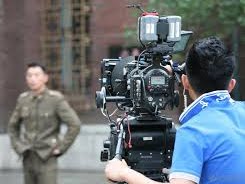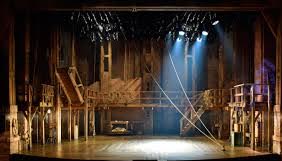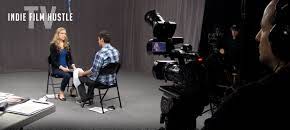*Production quality.
*The "look and feel" of the film.
*The film's success.
*They spark interest and make it easier to get actors or
actresses involved.
Part Four of Five: Casting the Crew/Edit
STEP: 1
Choose someone to direct. The director controls the creative aspect of the movie, and is a key connection between the crew and the cast. If you have an idea for movie and know exactly how it should look and feel, it would be a safe bet that the director is you, but if your not good at directing people and you’re not comfortable bossing people around, then, you can take a different approach on directing or just hire someone else and try to give them the full picture. You'll cast the major players, oversee the filming, and offer creative input where you see fit.
Choose someone to direct. The director controls the creative aspect of the movie, and is a key connection between the crew and the cast. If you have an idea for movie and know exactly how it should look and feel, it would be a safe bet that the director is you, but if your not good at directing people and you’re not comfortable bossing people around, then, you can take a different approach on directing or just hire someone else and try to give them the full picture. You'll cast the major players, oversee the filming, and offer creative input where you see fit.
 STEP: 2
STEP: 2Choose a Cinematographer, or Director of Photography. This person is in charge of making sure the lighting and actual filming of the movie go smoothly, as well as deciding with the director how each shot should be framed, lit, and shot. He or she manages the lighting and camera crews, or operates the camera on a small film.
STEP: 3
 assign someone the set design. This
person is in charge of making sure the sets correspond with the director's
creative vision. He or she might also be the props master (in charge of the
items that fill the set). •Costume, hair, and makeup design could be in the
same category on a very small production. On a large production, this person
would choose (and maybe even sew) every costume used in the film. On smaller
productions, this position is usually merged with another job.
assign someone the set design. This
person is in charge of making sure the sets correspond with the director's
creative vision. He or she might also be the props master (in charge of the
items that fill the set). •Costume, hair, and makeup design could be in the
same category on a very small production. On a large production, this person
would choose (and maybe even sew) every costume used in the film. On smaller
productions, this position is usually merged with another job.
 assign someone the set design. This
person is in charge of making sure the sets correspond with the director's
creative vision. He or she might also be the props master (in charge of the
items that fill the set). •Costume, hair, and makeup design could be in the
same category on a very small production. On a large production, this person
would choose (and maybe even sew) every costume used in the film. On smaller
productions, this position is usually merged with another job.
assign someone the set design. This
person is in charge of making sure the sets correspond with the director's
creative vision. He or she might also be the props master (in charge of the
items that fill the set). •Costume, hair, and makeup design could be in the
same category on a very small production. On a large production, this person
would choose (and maybe even sew) every costume used in the film. On smaller
productions, this position is usually merged with another job.
STEP: 4
put someone in charge of sound and music. The sound man may be one or more people. Dialog needs to be recorded either in scene, or looped in later during production. Sound effects, like gunshots and grenades or an explosion, all need to be created; music needs to be sourced, recorded, and mixed; and foley (footsteps, leather creaks, plates broken, doors slamming) all needs to be generated. The sound also needs to be mixed, edited, and lined up with the video in post-production. And remember, the music doesn't have to be very loud, it can be quiet in a quiet scene to the point where people aren't focusing on it as it now just acts an aid to capture the scene.
put someone in charge of sound and music. The sound man may be one or more people. Dialog needs to be recorded either in scene, or looped in later during production. Sound effects, like gunshots and grenades or an explosion, all need to be created; music needs to be sourced, recorded, and mixed; and foley (footsteps, leather creaks, plates broken, doors slamming) all needs to be generated. The sound also needs to be mixed, edited, and lined up with the video in post-production. And remember, the music doesn't have to be very loud, it can be quiet in a quiet scene to the point where people aren't focusing on it as it now just acts an aid to capture the scene.
STEP: 5
 cast your film. People in your
community might work for screen credits in low-budget films. Of course, it
would be advantageous to have a well-known name starring in your movie, but
learning to play to the strengths of the actors you do have will ensure that
you've got a great filmed product. If you need a cop character in your film,
call one up and ask if he'd be willing to film a couple scenes some afternoon.
Just make sure that the movie doesn't involve anything illegal while the police
officer is there, as this could not end well. If you need a college professor,
contact the school.[8] •Test the range of your actors. If you know that one of
them will have to cry in a sad scene, make sure he or she can do it before you
contract for the project.
cast your film. People in your
community might work for screen credits in low-budget films. Of course, it
would be advantageous to have a well-known name starring in your movie, but
learning to play to the strengths of the actors you do have will ensure that
you've got a great filmed product. If you need a cop character in your film,
call one up and ask if he'd be willing to film a couple scenes some afternoon.
Just make sure that the movie doesn't involve anything illegal while the police
officer is there, as this could not end well. If you need a college professor,
contact the school.[8] •Test the range of your actors. If you know that one of
them will have to cry in a sad scene, make sure he or she can do it before you
contract for the project.
 cast your film. People in your
community might work for screen credits in low-budget films. Of course, it
would be advantageous to have a well-known name starring in your movie, but
learning to play to the strengths of the actors you do have will ensure that
you've got a great filmed product. If you need a cop character in your film,
call one up and ask if he'd be willing to film a couple scenes some afternoon.
Just make sure that the movie doesn't involve anything illegal while the police
officer is there, as this could not end well. If you need a college professor,
contact the school.[8] •Test the range of your actors. If you know that one of
them will have to cry in a sad scene, make sure he or she can do it before you
contract for the project.
cast your film. People in your
community might work for screen credits in low-budget films. Of course, it
would be advantageous to have a well-known name starring in your movie, but
learning to play to the strengths of the actors you do have will ensure that
you've got a great filmed product. If you need a cop character in your film,
call one up and ask if he'd be willing to film a couple scenes some afternoon.
Just make sure that the movie doesn't involve anything illegal while the police
officer is there, as this could not end well. If you need a college professor,
contact the school.[8] •Test the range of your actors. If you know that one of
them will have to cry in a sad scene, make sure he or she can do it before you
contract for the project.
•Avoid scheduling conflicts. Make sure your actors can be
available on-set when you need them.
•Be careful of stunts that may injure your actors.





No comments:
Post a Comment